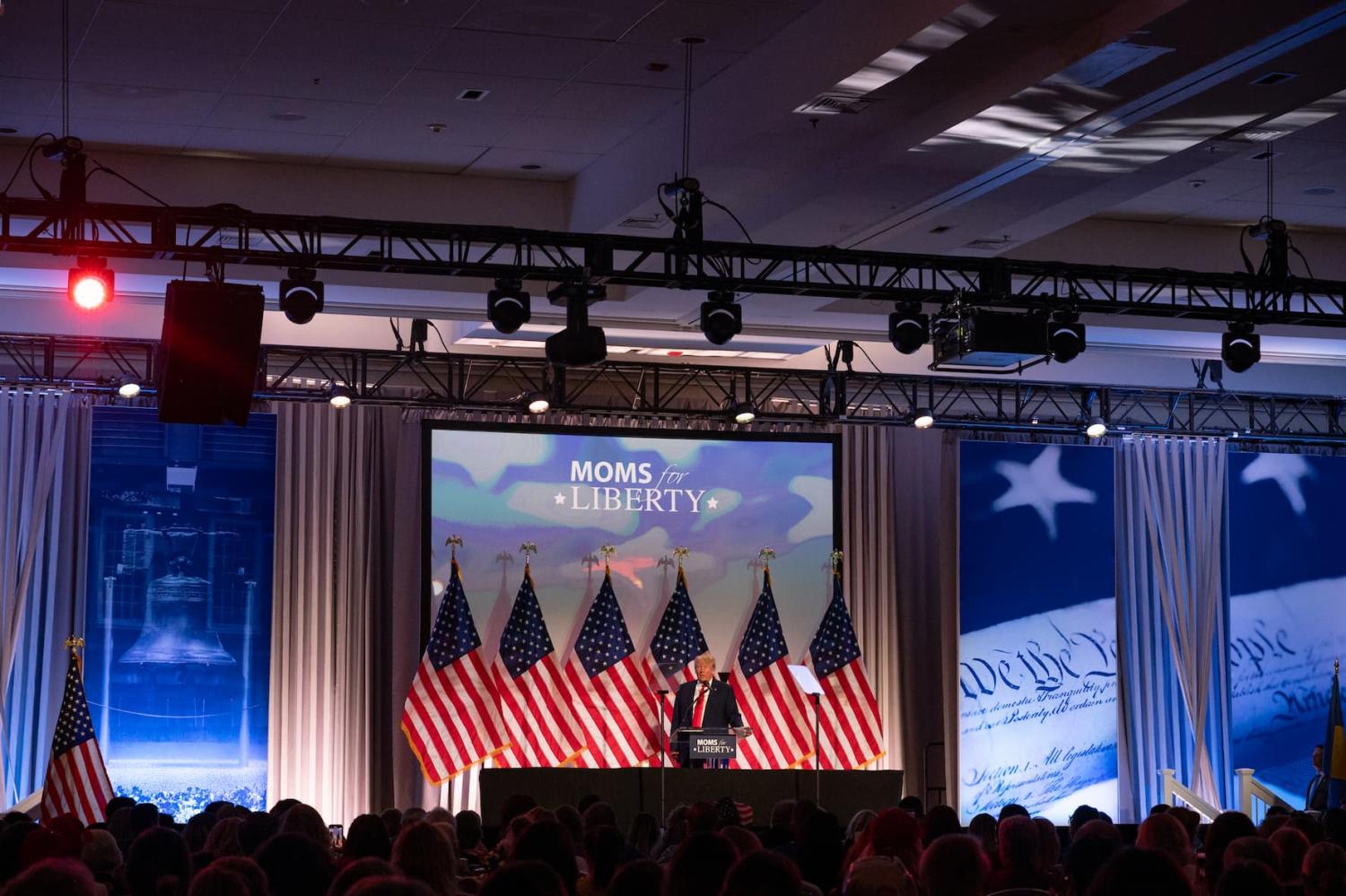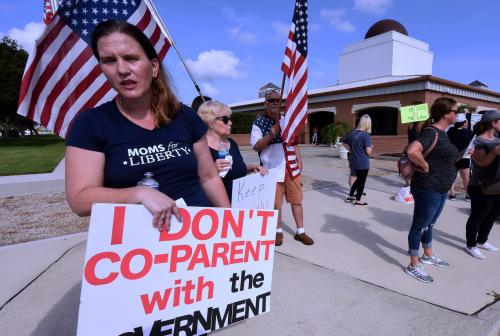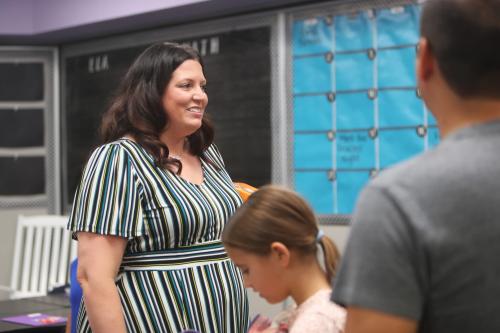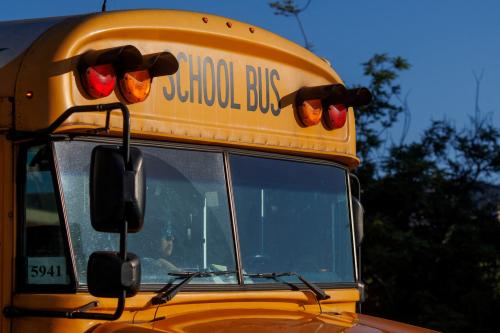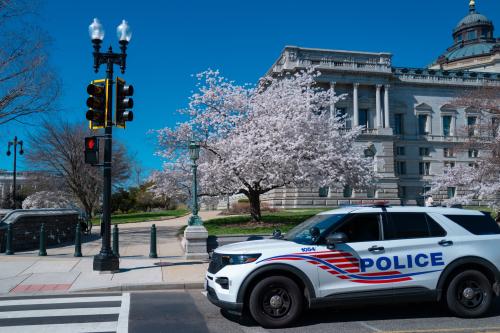Founded only three years ago, Moms for Liberty (M4L) has become a well-known, polarizing organization in U.S. education politics. The group emerged amid heated political disagreements over school re-openings and mask mandates and established itself as a central figure in ongoing battles over how race and racism, gender, and sexuality are taught in schools.
M4L has focused most of its attention on local school boards. It has worked to elect school board candidates who share M4L’s right-wing vision of “parental rights” in education and advocate for policies to bring that vision into U.S. schools.
Central to M4L’s work has been an endorsement process by which candidates can request support from their local M4L chapter. M4L reports that current M4L members can submit a request to their local chapter, which then interviews the chapter membership and votes on whether to endorse. M4L’s website pledges that endorsed candidates will receive “promotion and support” from the local chapter, a listing on the M4L national website, and the possibility of further support from the national M4L political action committee.
Of course, the central premise of a candidate endorsement is that being associated with the endorsing party brings more benefits than costs to the candidate. With M4L, that benefit-cost ratio isn’t always clear. On one hand, local school board elections tend to have low turnout, so persuading just a few like-minded people to vote can sway an election in the candidate’s favor. On the other hand, M4L has become such a polarizing brand—through its abrasive rhetoric, extreme policy positions, and most recently, a sex scandal involving one of the group’s co-founders—that some candidates might find being associated with M4L brings out more votes for the opposing candidate than for themselves.
In October 2023, we (and our colleague Sana Sinha) examined where Moms for Liberty chapters were located, where the organization was endorsing school board candidates, and where the candidates that M4L endorsed in 2022 won school board seats. We found a disproportionate share of chapters in suburban areas, with the bulk of endorsements coming in suburban and politically “blue” (Democratic) or “purple” (politically mixed) counties. A slight majority of these endorsed candidates who lost their races.
Now, with the fall 2023 elections behind us, we can look back at the full 2023 election cycle.
Our approach—and a challenge with studying Moms for Liberty
This analysis mimics part of the analysis that we conducted in October. We collected the names of candidates that M4L listed on its website as having endorsed. We then checked the outcome of those candidates’ elections, looking at both election results and school board biography pages.
We used the Internet Archive’s Wayback Machine to identify which names appeared on M4L’s list of endorsed candidates in 2023. The most useful list comes from the days immediately before the November 2023 elections, when M4L listed the candidates it was endorsing in that month’s elections as well as endorsements from earlier in 2023. M4L removed that list from its website soon thereafter. In its place, M4L now shows a “2023 win report” claiming that 90 of the 202 candidates it endorsed in 2023 were elected (45%).
By our count, only 166 candidates appeared on the M4L website. We don’t know how M4L came to that number of 202 endorsed candidates, nor the 90 wins that it claims among that group. We have reached out to M4L asking for clarification and have not received a response. A PDF of our clipped version of the M4L website’s endorsement list from November 7, 2023, is available here.
Notably, the M4L list did not include several candidates from high-profile races that attracted national attention in November 2023 because of M4L’s engagement. This includes the school board race in Bucks County, PA, where local reporters noted ambiguity in which candidates actually had an M4L endorsement. Also of note, the candidates associated with M4L—many of whom are missing from our list—performed poorly in these high-profile races, including in Bucks County.
A small—and declining—share of M4L-endorsed candidates won in 2023
By our count, a total of 54 of the 166 candidates that M4L publicly endorsed in 2023 won their elections. That’s a 33% win rate. Figure 1 shows the win rates for calendar years 2022 and 2023, overall and disaggregated by characteristics of the counties in which these candidates ran.
We should stress that we can’t determine whether these candidates won or lost because of an M4L endorsement. Too many other variables are involved to make that type of causal identification possible. Still, examining win rates is important both to assess the truth of M4L’s claims and because M4L has become an important player in education politics.
As seen in Figure 1, M4L-endorsed candidates won at nearly twice the rate in politically conservative counties (41%) and moderate counties (42%) as in politically liberal counties (22%). M4L endorsed more candidates in “blue” counties (n=74) than in “red” (n=64) and “purple” (n=26) counties, which could reflect that M4L found more disagreement with school board policies in these areas.
Figure 1 also shows that only about one-third of M4L-endorsed candidates won in suburban areas in 2023. This is notable given that the vast majority of M4L’s 2023 endorsements were in the suburbs (n=127).
Even with these differences by county characteristics, it’s striking that the win rate in every type of county (though 50% may be an arbitrary benchmark). Also striking: the across-the-board declines in win rates from 2022 to 2023. By our count, only 33% of M4L-endorsed candidates won in 2023 after 47% had won in 2022, and a drop of some magnitude is evident in every county type. For example, the win rate in suburbs slid from 54% to 34%.
Numerous factors could contribute to the year-to-year differences, which leaves us to speculate. To begin, the 2022 and 2023 election cycles differ in many ways—including the presence of congressional elections in 2022—and M4L identified far more endorsed candidates in 2022 (n=340) than in 2023 (n=166). We also suspect that M4L learned lessons from its earlier endorsements and the subsequent media coverage of those candidates’ performance. It’s possible, for example, that M4L is supporting candidates without issuing public endorsements in contexts where the M4L brand has become too polarizing. Of course, the changing politics of education in the U.S. and the growing national profile of—and resistance to—Moms for Liberty are also likely factors.
Still, it’s premature to write off Moms for Liberty
It’s hard to think of another education advocacy organization that has grown to such national prominence so quickly. While M4L founders claim that this growth has been fueled by the resonance of their messages, political polls, and election results say otherwise.
Still, M4L is a well-financed group with close ties to powerful individuals and institutions in conservative politics, and M4L represents a voting bloc that Republican political operatives are actively trying to court in the 2024 elections and beyond. Moreover, regardless of M4L’s own motives, perhaps its ultimate impact will have little to do with electoral outcomes. For example, in a recent piece, historian Jack Schneider and writer Jennifer Berkshire argue that M4L is supported by a broader conservative movement that is less concerned with flipping school boards than with sowing distrust in public education to support privatization efforts.
Regardless, M4L has become an important player in U.S. education politics—and one that should continue to draw the attention of researchers and journalists alike.
The authors contributed equally to this piece and are listed in alphabetical order.
The Brookings Institution is committed to quality, independence, and impact.
We are supported by a diverse array of funders. In line with our values and policies, each Brookings publication represents the sole views of its author(s).



